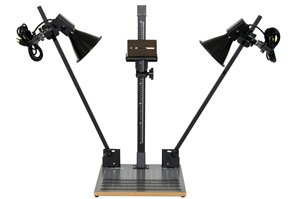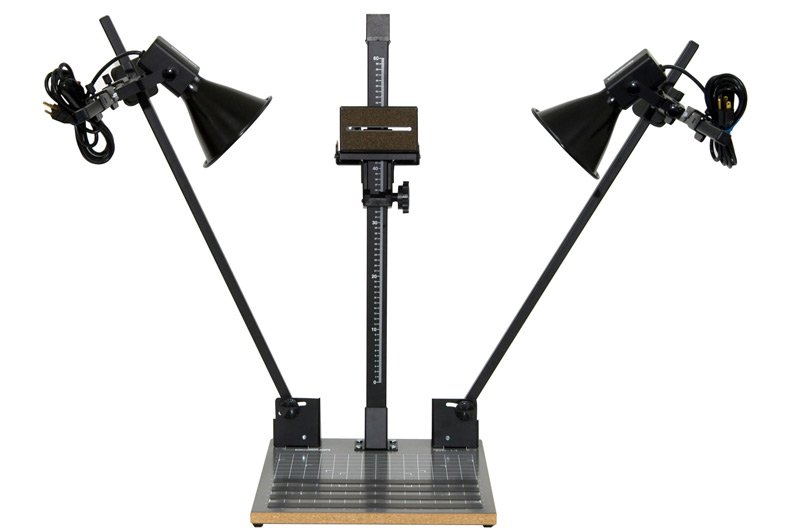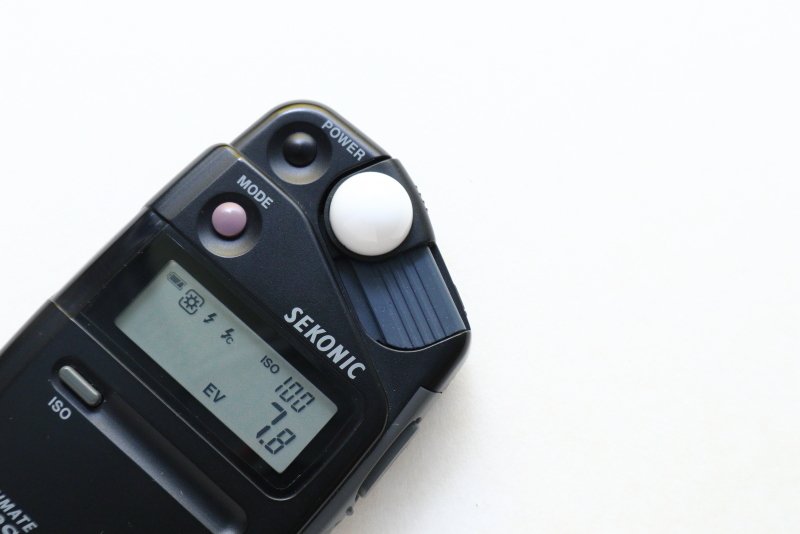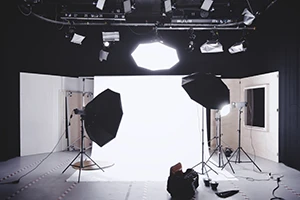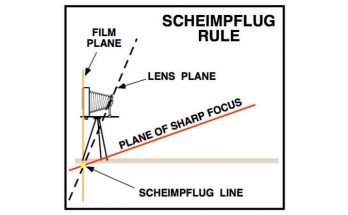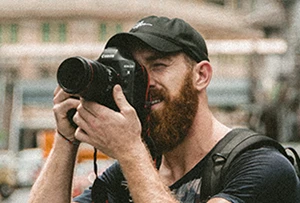What is a copy stand?
A copy stand, also known as a repro stand, is a device used to fascilitate the photography of large flat objects like artwork, books or manuscripts. Copy stands are used in archiving, artwork reproduction, animation, forensics and many more fields or arts and sciences. The typical photographic copy stand is comprised of a base board and a vertical column onto which the camera platform (or stage) rides. The device is very similar to an enarger in both construction and appearance, which is why the two are often mistaken.
A camera attached to the copy stand platform points squarely down to the center of the baseboard. The platform height can usually be adjusted and fixed along the column to accommodate different sized objects and lens focal lenghts. Typically, this is done via a hand crank mechanism and friction locks, although higher end motorized models are also offered. More advanced copy stand models may feature a spring loaded counterweight to offset the camera weight and make fine adjustments easier.
Simpler copy stand models come with plain flat baseboards onto which you simply lay or tape your objects. More sophisticated models may come with metal baseboards that enable the use of magnets, or backlit options for translucent materials. Some baseboards have grids or scales to aid positioning and provide a measurement aspect to the photographic documentation.
Often, copy stands incorporate a a lighting solution to provide flat, even illumination across the base board. The typical configuration for reproduction lighting features two or four light sources on flexible arms on either side of the baseboard. Traditionally, tungsten or halogen lighting has been used for this purpose, although flash and, more recently, LED options are available. Alternatively, regular studio lighting fixtures can be used with a copy stand. Due to the nature of most tasks involving a copy stand, a high CRI light source is essential.
What is a copy stand used for?
Copy stands are specialized devices, and most photographers can go their entire careers without ever needing one. In fact, many copy stand users are not photographers at all but technicians or scientists. The widest markets for these devices are museums and archives where they are used to reproduce or digitize books, artwork or manuscripts. Any time an item is too large, bulky or fragile for conventional scanning, a copy stand is used. You can see some high-end copy stands at work in the Stanford University Library’s video on digitizing above.
Copy stands are also used in scientific applications where controlled and repeatable small-scale photographic documentation is needed. Forensic studies is one such field, with copy stands used to analyze and document evidence to be used in investigations. Botanists, biologists and consevation professionals also employ the use of a copy stand for various documentation tasks. Philatelists and collectors can also often be found using one of these devices.
Furthermore, copy stands are used across various industries for quality testing, monitoring and documentation. In addition to photographic work, the stands can be used for video recording or even broadcasting of various processes. In many schools and universities, overhead projectors are being replaced with copy stand mounted digital cameras and video projectors.
Albeit limited, copy stands do have their place in the photographic studio. Apart from the obvious task of reproducing or digitizing images, the devices are also used to photograph small objects for catalogue work. The even illumination and the accurate, repeatable alignment of copy stands help streamline the product photography workflow.
With the growing availability of high pixel density digital camera chips, the copy stand has found yet another application. An increasing number of users have been foregoing traditional flatbed scanning of photographic film for a camera-based digitizing process. Paired with a light box, a copy stand is the perfect accessory for this task.
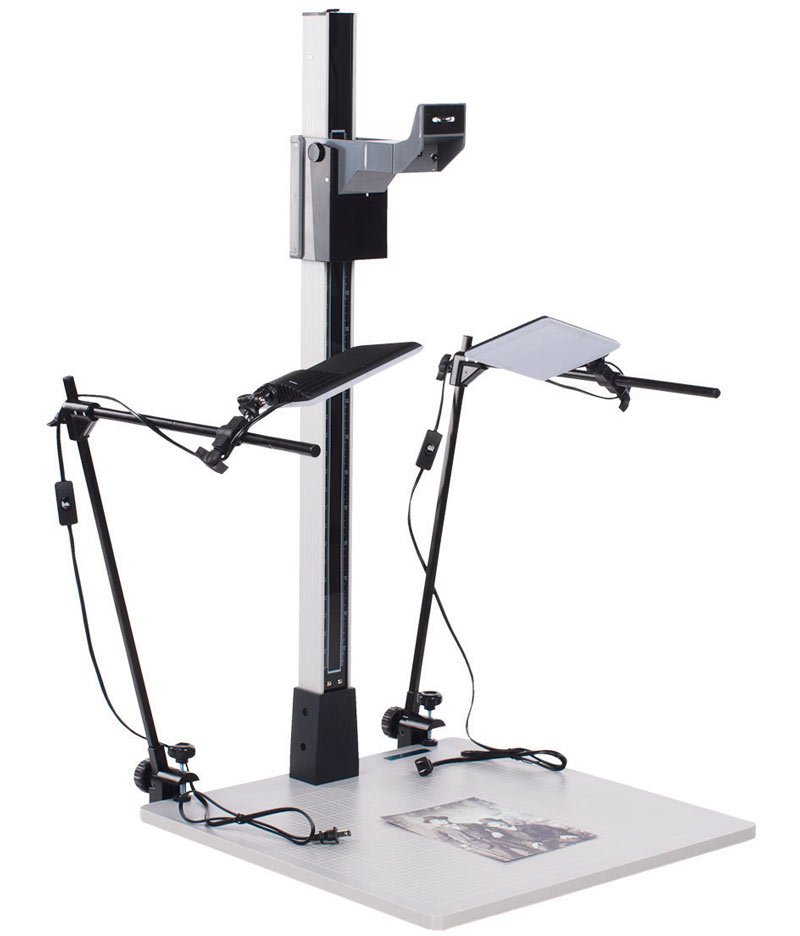
How is a copy stand used?
A copy stand is a rather simple and pretty intuitive piece of kit, but the tasks involving it usually require a rather high degree of precision. The basic parts of a copy stand are the baseboard, onto which you position the object to be photographed, and the column, onto which your camera is attached. Depending on the model, the stand may or may not come equipped with lights. Like most tools, the way a copy stand is used varies greatly with the task at hand. Here’s the key points:
Camera
It’s best to start by attaching you camera to the platform. Doing this after you’ve placed your original on the baseboard increases the risk of accidental damage to it while you fumble with the camera. Basic copy stands have a 1/4″ or a 3/8″ standard screw onto which you attach your camera, while more sophisticated models may have quick-release systems in place.
Due of the orientation of the camera and depending on the height, you might find it difficult to adjust settings once it’s mounted on the platform. Depending on the type of camera, you might also find it difficult to frame and compose the shot. With a 35mm film SLR, you can try to use a right angle viewfinder attachment. Medium format SLRs and TLRs with waist-level finders lend themselves readily to copy stand use, as they are made to be viewed from the top. Large format cameras may provide a particular challenge, but a reflex finder will help.
With a digital camera, there are more options available. A right angle viewfinder is still an option for viewfinder equipped models. If you have a camera with a tilting LCD it will certainly help for framing and composition. Alternatively, you can grab a step ladder or a small mirror to help you see the screen easier. However, the most elegant solution for digital copy stand photography is tethered shooting. If your camera supports this, shooting tethered while on the copy stand will improve your workflow significantly.
Lens
A key aspect in copy stand work is lens selection. At the very least, you need to ensure that your lens can focus as close as you need it to. Depending on the scale and magnification you are looking to achieve, you might need a macro lens. Alternatively, you can consider an extension tube, a close-up lens or a reversing ring with a regular lens.
Another thing to keep in mind is lens creep if you use a zoom. Due to the weight or the glass elements, many lenses will slowly extend when pointed straight down. Some lenses have locks on the zoom ring to prevent this, although they only lock the lens in one position, usually at the widest setting. If you experience lens creep, you might have to tape the zoom ring with non-residue gaffer tape to keep it in place.
Lights
Using a copy stand is all about control and repeatability. You can generally do most of your settings even before you’ve placed the object you want to photograph on the baseboard. A good place to start from is lighting and you have two possible approaches here.
The universal one, the way most users work with copy stands, is to set the lights so that they flood the whole baseboard with light. This way you are set for whatever you decide to do, and you would generally leave the lights alone unless a specific task comes along. If you are leaving your copy stand set up in the corner of your studio, this is the way to have it always ready to go.
On the other hand, while flooding the whole baseboard, which can be 50×50 cm or larger, with light will work for anything, it may not be optimal for all tasks. If you are only photographing stamps, for example, you can get the lights in much closer. This will yield a lot stronger illumination, and as a result higher shutter speeds and/or lower ISO settings, both of which will generally benefit image quality. In addition, not having all that extra light kicking about is bound to improve contrast even on a modern, multi-coated lens.
Lighting set up
Regardless of which approach you take, and whether you’re using the copy stand’s built in lights or external units, chances are you’ll need to do some adujstments to get the illumination as even as possible. Here are some general guidelines:
To avoid reflections off of the baseboard surface and any glossy flat items you may be photographing you generally need to keep the lights at a 45° angle. However, with three dimensional objects, you might need to adjust light positions to get optimal results.
If you have an incident light meter like the Sekonic above or a spotmeter, you can use it to check and adjust your lights until you achieve the necessary uniformity. In lieu of a light meter, you can also do test exposures and preview them in an image editing program. Many will provide a way to view brightness levels across the image, helping you identify falloff and hot spots.
Object
Once your camera is attached and ready to go, you can proceed with laying down whatever you need to photograph. For flat artwork or documents, there’s little to do beyond laying them down onto the baseboard. If you are going to be photographing a batch of similar items, it pays to mark the location you place the first one on. This way, once you have your settings, lights, height and focus all dialed in, you can simply swap the objects quickly and efficiently.
If your object refuses to stay flat (for example an old photograph, a book or a scrolled parchement) you can overlay it with a flat, clear piece of glass. Obviously, you need to be careful with reflections there, and may try a polarizer to get rid of any that may appear. Copy stand manufacturers like Kaiser and Smith Victor offer dedicated holders and accessories to facilitate proper capture while protecting fragile originals.
Do you need a copy stand?
Specialized as it is, a copy stand is not a piece of gear you will normally need as part of a typical photographic practice. For the rare instances you might need to get a plumb shot of an artwork or a document, using a suitable tripod insted of a copy stand will probably do the trick. However, if you increasingly find yourself fighting the laws of physics and optics to get that pesky tripod leg out of the picture, it might be time to consider adding a copy stand to your kit.
These devices are not the smallest or lightest, and although many can be disasembled for easier storage and transport, they are best suited for the studio. Depending on the type of work you are looking to do, you can get a stand with or without lights. If you already have studio lights, you can usually easily repurpose them for repro work. If, on the other hand, you don’t normally use lights in your work, selecting a copy stand model with lighting might be your best bet.
Copy Stand Q&A
What copy stand is best for film scanning?
As discussed above, film scanning, or more accurately digitizing (as there’s no scanner involved) is one of the most popular applications of copy stands today. To select the best copy stand for film digitizing, we need to keep a couple of thing in mind.
First is size. Unless you are working with ULF (ultra large format) film, you will typically be working with relatively small objects. In addition, to achieve the magnification usually sought after in film scanning, the camera needs to be relatively close to the film itself. Therefore, you do not need a very big or tall copy stand, if you are only going to use it for film digitizing.
Second, to digitize film you will be needing a backlight. Unless you are planning to use the copy stand for other things, you can skip on the built-in lights, as you will never need them for film.
In conclusion, a simple, solid, no-frills solution like the 30 inch Kaiser RS 2-XA kit or the 36 inch Smith-Victor CS36 is an excellent choice for the purpose of film digitizing.

